Muyao Niu
R3-Avatar: Record and Retrieve Temporal Codebook for Reconstructing Photorealistic Human Avatars
Mar 17, 2025Abstract:We present R3-Avatar, incorporating a temporal codebook, to overcome the inability of human avatars to be both animatable and of high-fidelity rendering quality. Existing video-based reconstruction of 3D human avatars either focuses solely on rendering, lacking animation support, or learns a pose-appearance mapping for animating, which degrades under limited training poses or complex clothing. In this paper, we adopt a "record-retrieve-reconstruct" strategy that ensures high-quality rendering from novel views while mitigating degradation in novel poses. Specifically, disambiguating timestamps record temporal appearance variations in a codebook, ensuring high-fidelity novel-view rendering, while novel poses retrieve corresponding timestamps by matching the most similar training poses for augmented appearance. Our R3-Avatar outperforms cutting-edge video-based human avatar reconstruction, particularly in overcoming visual quality degradation in extreme scenarios with limited training human poses and complex clothing.
Physics-Based Adversarial Attack on Near-Infrared Human Detector for Nighttime Surveillance Camera Systems
Dec 18, 2024Abstract:Many surveillance cameras switch between daytime and nighttime modes based on illuminance levels. During the day, the camera records ordinary RGB images through an enabled IR-cut filter. At night, the filter is disabled to capture near-infrared (NIR) light emitted from NIR LEDs typically mounted around the lens. While RGB-based AI algorithm vulnerabilities have been widely reported, the vulnerabilities of NIR-based AI have rarely been investigated. In this paper, we identify fundamental vulnerabilities in NIR-based image understanding caused by color and texture loss due to the intrinsic characteristics of clothes' reflectance and cameras' spectral sensitivity in the NIR range. We further show that the nearly co-located configuration of illuminants and cameras in existing surveillance systems facilitates concealing and fully passive attacks in the physical world. Specifically, we demonstrate how retro-reflective and insulation plastic tapes can manipulate the intensity distribution of NIR images. We showcase an attack on the YOLO-based human detector using binary patterns designed in the digital space (via black-box query and searching) and then physically realized using tapes pasted onto clothes. Our attack highlights significant reliability concerns for nighttime surveillance systems, which are intended to enhance security. Codes Available: https://github.com/MyNiuuu/AdvNIR
Bundle Adjusted Gaussian Avatars Deblurring
Nov 24, 2024Abstract:The development of 3D human avatars from multi-view videos represents a significant yet challenging task in the field. Recent advancements, including 3D Gaussian Splattings (3DGS), have markedly progressed this domain. Nonetheless, existing techniques necessitate the use of high-quality sharp images, which are often impractical to obtain in real-world settings due to variations in human motion speed and intensity. In this study, we attempt to explore deriving sharp intrinsic 3D human Gaussian avatars from blurry video footage in an end-to-end manner. Our approach encompasses a 3D-aware, physics-oriented model of blur formation attributable to human movement, coupled with a 3D human motion model to clarify ambiguities found in motion-induced blurry images. This methodology facilitates the concurrent learning of avatar model parameters and the refinement of sub-frame motion parameters from a coarse initialization. We have established benchmarks for this task through a synthetic dataset derived from existing multi-view captures, alongside a real-captured dataset acquired through a 360-degree synchronous hybrid-exposure camera system. Comprehensive evaluations demonstrate that our model surpasses existing baselines.
ToMiE: Towards Modular Growth in Enhanced SMPL Skeleton for 3D Human with Animatable Garments
Oct 10, 2024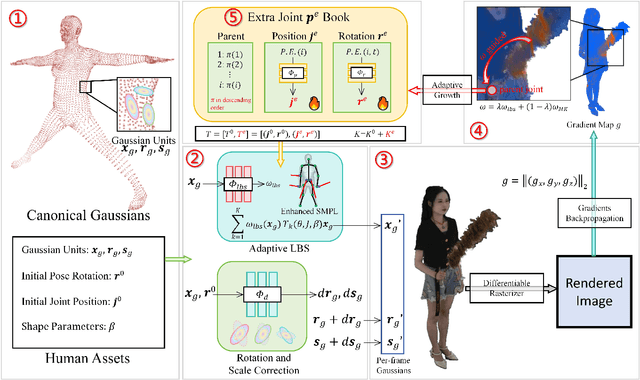

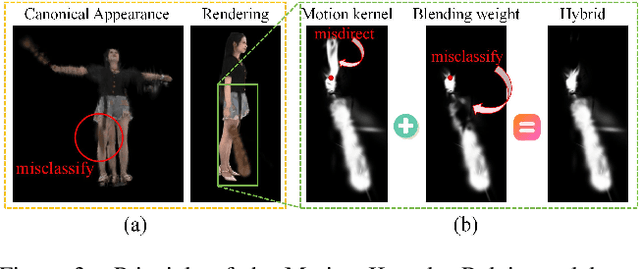
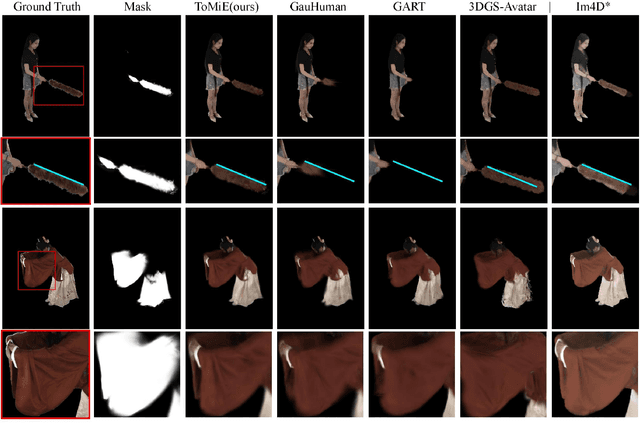
Abstract:In this paper, we highlight a critical yet often overlooked factor in most 3D human tasks, namely modeling humans with complex garments. It is known that the parameterized formulation of SMPL is able to fit human skin; while complex garments, e.g., hand-held objects and loose-fitting garments, are difficult to get modeled within the unified framework, since their movements are usually decoupled with the human body. To enhance the capability of SMPL skeleton in response to this situation, we propose a modular growth strategy that enables the joint tree of the skeleton to expand adaptively. Specifically, our method, called ToMiE, consists of parent joints localization and external joints optimization. For parent joints localization, we employ a gradient-based approach guided by both LBS blending weights and motion kernels. Once the external joints are obtained, we proceed to optimize their transformations in SE(3) across different frames, enabling rendering and explicit animation. ToMiE manages to outperform other methods across various cases with garments, not only in rendering quality but also by offering free animation of grown joints, thereby enhancing the expressive ability of SMPL skeleton for a broader range of applications.
StereoCrafter: Diffusion-based Generation of Long and High-fidelity Stereoscopic 3D from Monocular Videos
Sep 11, 2024



Abstract:This paper presents a novel framework for converting 2D videos to immersive stereoscopic 3D, addressing the growing demand for 3D content in immersive experience. Leveraging foundation models as priors, our approach overcomes the limitations of traditional methods and boosts the performance to ensure the high-fidelity generation required by the display devices. The proposed system consists of two main steps: depth-based video splatting for warping and extracting occlusion mask, and stereo video inpainting. We utilize pre-trained stable video diffusion as the backbone and introduce a fine-tuning protocol for the stereo video inpainting task. To handle input video with varying lengths and resolutions, we explore auto-regressive strategies and tiled processing. Finally, a sophisticated data processing pipeline has been developed to reconstruct a large-scale and high-quality dataset to support our training. Our framework demonstrates significant improvements in 2D-to-3D video conversion, offering a practical solution for creating immersive content for 3D devices like Apple Vision Pro and 3D displays. In summary, this work contributes to the field by presenting an effective method for generating high-quality stereoscopic videos from monocular input, potentially transforming how we experience digital media.
KFD-NeRF: Rethinking Dynamic NeRF with Kalman Filter
Jul 18, 2024
Abstract:We introduce KFD-NeRF, a novel dynamic neural radiance field integrated with an efficient and high-quality motion reconstruction framework based on Kalman filtering. Our key idea is to model the dynamic radiance field as a dynamic system whose temporally varying states are estimated based on two sources of knowledge: observations and predictions. We introduce a novel plug-in Kalman filter guided deformation field that enables accurate deformation estimation from scene observations and predictions. We use a shallow Multi-Layer Perceptron (MLP) for observations and model the motion as locally linear to calculate predictions with motion equations. To further enhance the performance of the observation MLP, we introduce regularization in the canonical space to facilitate the network's ability to learn warping for different frames. Additionally, we employ an efficient tri-plane representation for encoding the canonical space, which has been experimentally demonstrated to converge quickly with high quality. This enables us to use a shallower observation MLP, consisting of just two layers in our implementation. We conduct experiments on synthetic and real data and compare with past dynamic NeRF methods. Our KFD-NeRF demonstrates similar or even superior rendering performance within comparable computational time and achieves state-of-the-art view synthesis performance with thorough training.
RS-NeRF: Neural Radiance Fields from Rolling Shutter Images
Jul 14, 2024Abstract:Neural Radiance Fields (NeRFs) have become increasingly popular because of their impressive ability for novel view synthesis. However, their effectiveness is hindered by the Rolling Shutter (RS) effects commonly found in most camera systems. To solve this, we present RS-NeRF, a method designed to synthesize normal images from novel views using input with RS distortions. This involves a physical model that replicates the image formation process under RS conditions and jointly optimizes NeRF parameters and camera extrinsic for each image row. We further address the inherent shortcomings of the basic RS-NeRF model by delving into the RS characteristics and developing algorithms to enhance its functionality. First, we impose a smoothness regularization to better estimate trajectories and improve the synthesis quality, in line with the camera movement prior. We also identify and address a fundamental flaw in the vanilla RS model by introducing a multi-sampling algorithm. This new approach improves the model's performance by comprehensively exploiting the RGB data across different rows for each intermediate camera pose. Through rigorous experimentation, we demonstrate that RS-NeRF surpasses previous methods in both synthetic and real-world scenarios, proving its ability to correct RS-related distortions effectively. Codes and data available: https://github.com/MyNiuuu/RS-NeRF
MOFA-Video: Controllable Image Animation via Generative Motion Field Adaptions in Frozen Image-to-Video Diffusion Model
Jun 02, 2024
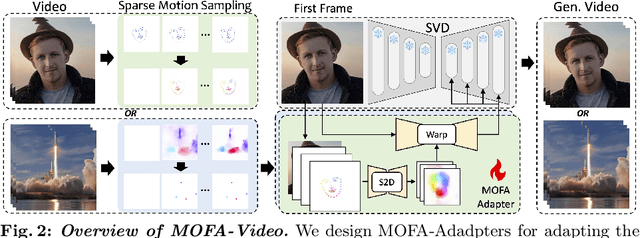
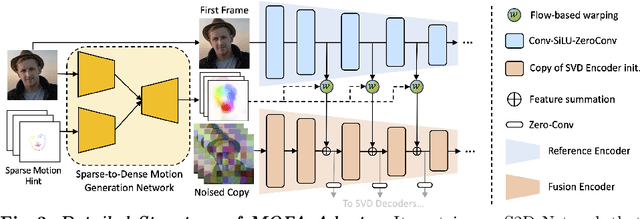

Abstract:We present MOFA-Video, an advanced controllable image animation method that generates video from the given image using various additional controllable signals (such as human landmarks reference, manual trajectories, and another even provided video) or their combinations. This is different from previous methods which only can work on a specific motion domain or show weak control abilities with diffusion prior. To achieve our goal, we design several domain-aware motion field adapters (\ie, MOFA-Adapters) to control the generated motions in the video generation pipeline. For MOFA-Adapters, we consider the temporal motion consistency of the video and generate the dense motion flow from the given sparse control conditions first, and then, the multi-scale features of the given image are wrapped as a guided feature for stable video diffusion generation. We naively train two motion adapters for the manual trajectories and the human landmarks individually since they both contain sparse information about the control. After training, the MOFA-Adapters in different domains can also work together for more controllable video generation. Project Page: https://myniuuu.github.io/MOFA_Video/
CV-VAE: A Compatible Video VAE for Latent Generative Video Models
May 30, 2024Abstract:Spatio-temporal compression of videos, utilizing networks such as Variational Autoencoders (VAE), plays a crucial role in OpenAI's SORA and numerous other video generative models. For instance, many LLM-like video models learn the distribution of discrete tokens derived from 3D VAEs within the VQVAE framework, while most diffusion-based video models capture the distribution of continuous latent extracted by 2D VAEs without quantization. The temporal compression is simply realized by uniform frame sampling which results in unsmooth motion between consecutive frames. Currently, there lacks of a commonly used continuous video (3D) VAE for latent diffusion-based video models in the research community. Moreover, since current diffusion-based approaches are often implemented using pre-trained text-to-image (T2I) models, directly training a video VAE without considering the compatibility with existing T2I models will result in a latent space gap between them, which will take huge computational resources for training to bridge the gap even with the T2I models as initialization. To address this issue, we propose a method for training a video VAE of latent video models, namely CV-VAE, whose latent space is compatible with that of a given image VAE, e.g., image VAE of Stable Diffusion (SD). The compatibility is achieved by the proposed novel latent space regularization, which involves formulating a regularization loss using the image VAE. Benefiting from the latent space compatibility, video models can be trained seamlessly from pre-trained T2I or video models in a truly spatio-temporally compressed latent space, rather than simply sampling video frames at equal intervals. With our CV-VAE, existing video models can generate four times more frames with minimal finetuning. Extensive experiments are conducted to demonstrate the effectiveness of the proposed video VAE.
Visibility Constrained Wide-band Illumination Spectrum Design for Seeing-in-the-Dark
Mar 21, 2023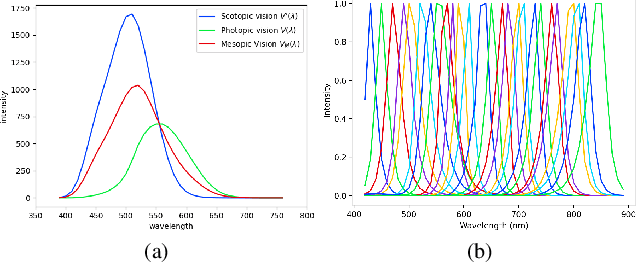

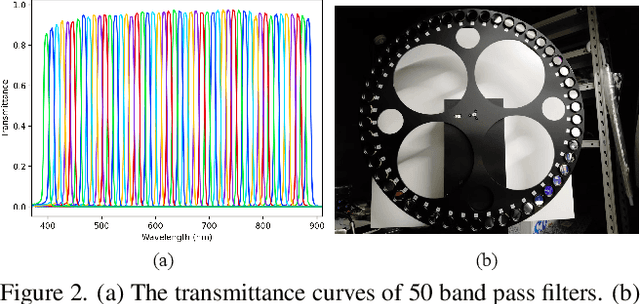
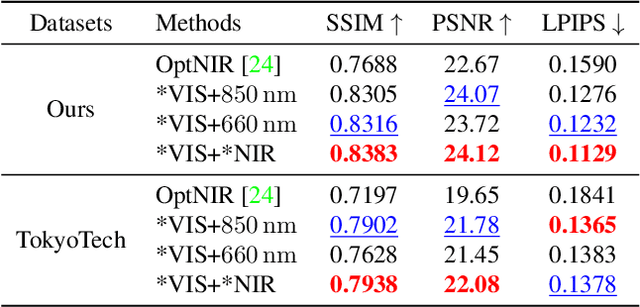
Abstract:Seeing-in-the-dark is one of the most important and challenging computer vision tasks due to its wide applications and extreme complexities of in-the-wild scenarios. Existing arts can be mainly divided into two threads: 1) RGB-dependent methods restore information using degraded RGB inputs only (\eg, low-light enhancement), 2) RGB-independent methods translate images captured under auxiliary near-infrared (NIR) illuminants into RGB domain (\eg, NIR2RGB translation). The latter is very attractive since it works in complete darkness and the illuminants are visually friendly to naked eyes, but tends to be unstable due to its intrinsic ambiguities. In this paper, we try to robustify NIR2RGB translation by designing the optimal spectrum of auxiliary illumination in the wide-band VIS-NIR range, while keeping visual friendliness. Our core idea is to quantify the visibility constraint implied by the human vision system and incorporate it into the design pipeline. By modeling the formation process of images in the VIS-NIR range, the optimal multiplexing of a wide range of LEDs is automatically designed in a fully differentiable manner, within the feasible region defined by the visibility constraint. We also collect a substantially expanded VIS-NIR hyperspectral image dataset for experiments by using a customized 50-band filter wheel. Experimental results show that the task can be significantly improved by using the optimized wide-band illumination than using NIR only. Codes Available: https://github.com/MyNiuuu/VCSD.
 Add to Chrome
Add to Chrome Add to Firefox
Add to Firefox Add to Edge
Add to Edge